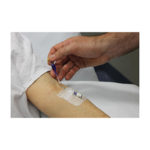 Researchers from the Caboolture Hospital in Queensland, Australia found that medical skin glue can be used to hold hospital intravenous lines in place, significantly reducing the risk of infection, pain, blockage or overall failure. The team’s work was published in the Annals of Emergency Medicine.
Researchers from the Caboolture Hospital in Queensland, Australia found that medical skin glue can be used to hold hospital intravenous lines in place, significantly reducing the risk of infection, pain, blockage or overall failure. The team’s work was published in the Annals of Emergency Medicine.
The Emergency Medicine Foundation of Australia, along with Queensland Health, funded the research and patient trials, which EMF said ran for several months at Caboolture Hospital. The work is undergoing a cost-benefit analysis by health economists at Griffith University. The lead researcher, Dr. Simon Bugden, said that within the 1st 48 hours, IV lines have a failure rate of 29-40% in Australia and can be as high as 90% internationally.
“We found that by using medical skin glue, we could reduce the failure rate to below 17 per cent,” lead researcher Dr. Simon Bugden said in prepared remarks. “The glue made IV lines harder to unintentionally remove and was also shown to kill the bacteria that most commonly cause infections. The other major benefit was patient comfort, with patients in the trial reporting that the glue caused less irritation and they were less worried about the lines falling out. Doctors place more than 10 million IV lines in Australia each year – and more than 300 million in the US – so reducing the need to replace IV lines will save staff time and free up valuable healthcare resources.”
“There has been no improvement to the current procedure of inserting and securing IV lines in several decades, despite the rate of failure,” chair of the Emergency Medicine Foundation of Australia Sally McCarthy added. “Dr. Bugden’s method could be simply and cost-effectively introduced in hospitals worldwide. EMF is committed to ensuring Australia continues to stay at the forefront of emergency medicine care by funding to dedicated research in this field.”

